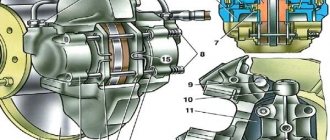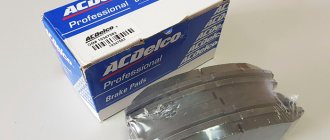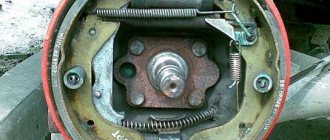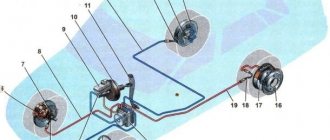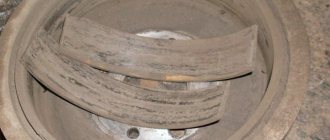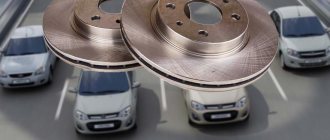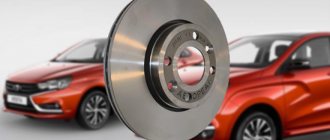Brake pads – the most important element of the braking system. The effectiveness of the brakes depends on them. Good, correct pads will not only perform their functions for a long time and reliably, but will also keep the brake disc or drum safe and sound for many years. On the contrary, bad, low-quality pads can ruin the brake disc by making deep grooves in it, etc.
Brake pads for disc brakes
Brake pads are different. Moreover, we are not talking about the structure and design, but primarily about the material of the friction linings, which actually perform the braking. Today there are a great variety of friction mixtures. Each company has its own recipe and ingredients. The mixture may contain 15 or more different components. Their proportions are clearly maintained. Any change in the proportion of one or another component can significantly change the properties of future brake linings, up to their complete inoperability.
The basis of the friction mixture is the reinforcing component. The strength, heat resistance and stability of the braking properties of the product depend on it. In recent years, stable types of friction products have emerged, which received their name precisely based on their reinforcing component. Asbestos, non-asbestos and organic (based on organic fibers) components are distinguished.
The first, as the name implies, use asbestos as a reinforcing element. The harmfulness of this material to humans has already become the talk of the town. Many car repair and maintenance manuals say that changing asbestos-containing brake pads and even removing wheels (if you have such brakes) must be done with extreme caution, taking care of respiratory and eye protection in advance.
Non-asbestos is a friction material in which the role of a reinforcing component is performed by other components. This could be steel wool, copper, brass shavings, various polymer compositions, etc. In budget pads, manufacturers use a mixture of organic and inorganic fibers, balancing between the coefficient of friction, wear resistance and the final price of the pad. If we are talking about expensive pads, although intended for road cars, then manufacturers can include granules of soft metals and artificial graphite, Kevlar and carbon fibers, thereby increasing the thermal stability of the friction material.
The most modern friction materials at the moment are based on organic fibers. These pads have the best braking properties. It is not for nothing that they are installed on modern Formula 1 cars, where the load on the brakes (by the standards of city cars) is simply prohibitive. After all, they have to reduce the speed of the car from 300 to 60 km/h in a matter of seconds or even a fraction of a second. Unfortunately, like any high-tech and knowledge-intensive products, the cost of such pads is affordable only for such “money” types of motorsport.
And let's remember the warmth again. The pads must also be cooled, but, unlike discs, they must not allow heat to pass through themselves. As they heat up, they will certainly begin to heat the working brake cylinders, and they, in turn, warm the brake fluid, and if it boils, the brakes will stop working, with all the ensuing consequences. This is why it is so important to provide a thermal barrier between the friction linings and the metal base of the brake pad.
Brake pads - what are they?
Brake pads are one of the main components of a disc brake. The principle of operation is simple - when you press the brake pedal, the pad is pressed by the caliper against the brake disc, friction occurs and the car slows down. These elements are installed on both sides of the disk. The duration of the braking distance completely depends on the quality of the pads.
(1 - brake pads, 2 - brake caliper, 3 - brake disc)
The main feature of the material used in the manufacture of brake pads is its abrasion resistance. In this case, the material must be non-flammable, so that melting or spontaneous combustion does not occur during strong friction. Much attention is also paid to the operating temperature of the product. This indicator directly depends on the material used in production. A temperature variation of 300 to 350 degrees Celsius is considered normal. On more powerful foreign cars and sports cars, this figure increases to 900 degrees Celsius. But if the vehicle is not used in auto racing, and the normal speed limit does not exceed that established in a populated area, then there is no point in installing such products with an increased operating temperature.
The friction coefficient is another important indicator when choosing brake elements. The standard figure is 0.3-0.5. As the indicator increases, the quality of braking increases. If the element is poorly heated, the friction coefficient increases, which means the product wears out much faster. This leads to more frequent and pointless pad changes. Therefore, it is important to select a model that will match not only the car model, but also the owner’s driving style.
In appearance, the pads resemble oblong plates. On modern car models, additional sensors are often installed that notify the owner of pad wear in order to avoid possible breakdowns or accidents.
For information on how to check ABS sensors on a car, read this article.
Friction lining maintenance
Over time, brake linings wear out and the question of replacing them arises. The working life of the pads is about 20-30 thousand km of vehicle mileage. But in this situation it is necessary to focus on the actual wear of the friction linings.
This can be determined visually: the working surface of the pad should not be less than 2 mm. In modern brands of cars, a wear sensor is built into the design of the brake mechanism, which will promptly warn the owner about the need to replace the brake pads.
Types of brake pads on disc brakes
Brake pads are classified according to the material from which they are made. Conventionally, they can be divided into 4 types, which have their own advantages and disadvantages.
Semi-metallic
These elements are 30-60% metal. In most cases, manufacturers use powder that includes iron, graphite, and sometimes copper. The powder is mixed with inorganic components and a friction modifier is added; it provides a better connection of all components. The main advantage of semi-metallic products is their high heat transfer rate. Disadvantages include poor wear resistance. Pads made of this material cause inconvenience to the driver with loud and unpleasant sounds made during braking. They do not perform their function very well in the cold.
Organic
The main components of this species are organic substances such as glass, kelp, carbon compounds, resin and rubber. They are not as rough as semi-metallic ones, and are more delicate to the parts they come into contact with. They do not cause any inconvenience due to annoying sounds. Another advantage is the low price. Cons: during operation, they emit a lot of dust particles, which clog the ventilated discs. They wear out quickly and perform their job poorly when moisture gets on the surface of the product.
Metal
The type of pads is more expensive, but the quality characteristics of these products are higher. They are similar in composition to organic ones, but the main “bonus” component is steel or copper. Thanks to the addition of these substances, the heat transfer rate increases significantly. The quality of braking is noticeably improved. A fairly effective tool, if not for the main drawback. They erase a car's brake disc faster.
Ceramic
This type of brake elements is as efficient as possible, which could not but affect the cost. Ceramic pads are considered the most expensive products. They provide the best quality braking process. Ceramics are not affected by moisture and air temperature. Resistant to abrasion during operation. They are gentle on the disc and do not generate dust like organic ones. The material consists of several components: ceramic fibers, various non-ferrous metals.
Operational Requirements
All this is due to high requirements for the quality of the product. Brake linings function in very difficult and aggressive conditions. Therefore, they must not only have good friction, but also provide effective and safe braking in critical conditions:
- with sudden changes in temperature;
- increased contamination and dustiness of the mechanism;
- ingress of water and various chemically destructive substances.
At the same time, friction linings reduce the noise level during friction against the brake disc or drum. If the quality of the lining material is poor, then when braking, a characteristic squeaking, unpleasant, loud sound is produced, which almost every person on the roadway has heard.
How to choose brake pads
In this matter, it is better to forget about saving. The safety of not only your life, but also that of other road users depends on this. Therefore, you should not buy cheap products, and it is better to entrust the choice of model to a specialist who will competently assess your driving style, the load on the brakes and the braking system as a whole. If it is not possible to contact a specialist, then pay attention to several factors:
- this should be a specialized point of sale
- the integrity of the packaging must not be compromised
- The products themselves must be intact, the metal base must not be bent, no cracks, no peeling.
- No foreign bodies
Size of wipers for Nissan Primera P12
Published: 06/12/2020
Spread the love
Spread the love Wipers for Nissan Primera 2013 Wiper blades for Nissan Primera 1990-2013 You need to know: the main feature of the production quality of wipers is the area of the glass that they clean from dirt, however, the area of the wipers is justified by the design of the car body and has a limit, exceeding which can cause a reason for the wipers to contact each other. Which wipers are better for...
Size of wipers on Nissan Primera P12 Read more »
Repair and replacement of brake pads
The rate at which this product wears out depends on the mileage and driving habits of a particular car owner. In any case, after several tens of thousands of kilometers the part wears out completely, in which case the pads need to be changed. In other cases, repairs are possible. In what situations should you pay attention to improper operation of brake pads:
- When braking, the vehicle pulls to the side
- Squealing when braking
- Brakes "stick"
- When braking, it is necessary to apply great force to the pedal
- Braking is ineffective
- Unable to release the brakes on one of the wheels
In some cases, to fix a breakdown, it is necessary to adjust the pad or completely replace it. If you have not previously dealt with self-repair, then put your car in the hands of professionals. They will be able to fully assess the malfunction and take all necessary actions. If the situation is such that there is nowhere to turn for help, and replacement of the pads is necessary now, then try the following steps:
- Secure the car stationary, lift the side on which the pad will be replaced and remove the wheel.
- Turn the steering wheel in the direction on which the product will be replaced.
- Unscrew the wheel.
- Remove the spring mechanism from the caliper and remove the pads.
- Reassemble in reverse order.
There is nothing complicated about this, but you need to be extremely careful and careful. And at the first opportunity, take a minute and visit an auto service center so that professionals can carry out diagnostics.
ECE R90 standard
Brake components are often marked as ECE R90 (sometimes written as R-90 or 90R). What is this standard and why is it important?
Before understanding this issue, it is worth remembering that all auto parts sold on the market are divided into 3 categories:
- original (OEM) - the same as those installed from the assembly line;
- non-original or aftermarket - from the same suppliers that produce original spare parts, but supplied to the market under the manufacturer’s brand;
— products for developing countries that do not go to the European market.
The quality of original spare parts is monitored not only by the manufacturer itself, but also by the automaker. Thus, OEM spare parts undergo double testing, due to which they are considered (and are) the highest quality goods.
But until recently, the quality of branded (non-original) spare parts was solely the responsibility of the manufacturer itself. And in 1999, Europe adopted the ECE R90 rules (Economic Commission for Europe rules No. 90), according to which non-original brake elements must meet the primary requirements of the automaker by at least 85%. Products that do not comply with the ECE R90 standard cannot be sold within the EU and are mainly exported to countries with less stringent requirements.
Thus, the R90 marking can be considered a kind of indicator of decent product quality.
Example of ECE R90 marking on brake pads
Car wiper size chart
Published: November 23, 2017
Spread the love
Spread the love Dimensions of wipers for carsContents1 Dimensions of wipers for cars1.1 Size of wiper blades for Ford Focus 21.1.1 Replacing wipers for Ford Focus 2 video1.2 Size of wiper blades for Solaris1.2.1 How to change windshield wiper blades on a Solaris video1.3 Size of wiper blades for Chevrolet Cruze hatchback1 .3.1 Replacing windshield wiper blades on a Chevrolet Cruze1.4 Size of wiper blades VAZ 21101.4.1 Replacing wipers on a VAZ 2110...
Size chart for car wipers Read more »
Bosch windshield wiper blade framed and frameless
Published: 09/13/2020
Spread the love
Spread the love Bosch windshield wiper blades, Bosch selectionContents1 Bosch wiper blades, Bosch selection1.1 Bosch wiper blade catalog1.2 Bosch wiper blade replacement1.3 Bosch wiper blade table article number One of the old companies in the field of automotive components, which was born back in 1885 year. It's no secret that Bosch creates not only automotive accessories, but also a huge...
Bosch windshield wiper blade framed and frameless Read more »
Size of wipers for Ford Kuga 2
Published: 01/07/2018
Spread the love
Spread the love Ford Kuga wiper size Ford showed its first compact crossover in 2006. By the standards of those days, the car was quite futuristic and few would have thought that such a car would appear on the roads in the near future. But literally two years later, brand new Ford Kugas appeared in dealer showrooms. Yes, definitely Ford long enough...
Size of wipers on Ford Kuga 2 Read more »
